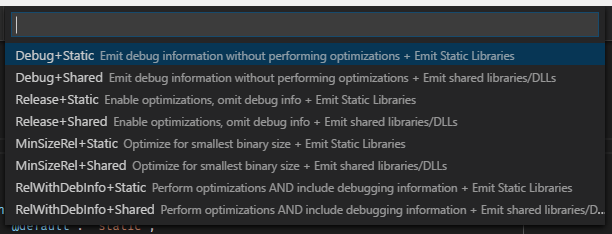6.2 KiB
Build Variants
Some build systems support build variants as a way to represent a commonly used
set of build settings and ways to mix and match them. cmake-variants.json
(or a YAML variant, cmake-variants.yaml) provides a way to encode a set of
project build settings to users in a way that is convenient, descriptive, and
easy to use. CMake Tools 0.6.0 features full support for working with variants
in this manner.
cmake-variants.json
The most important part of the system is cmake-variants.json, which encodes
available build settings in such a way that they can be parsed and analyzed by
automated tooling, as well as human users. Here is the default variants
configuration used by CMake Tools when one is not present in a project directory:
{
"buildType": {
"default$": "debug",
"description$": "the build type to use",
"debug": {
"oneWordSummary$": "Debug",
"description$": "Emit debug information without performing optimizations",
"buildType": "Debug"
},
"release": {
"oneWordSummary$": "Release",
"description$": "Enable optimizations, omit debug info",
"buildType": "Release"
},
"minsize": {
"oneWordSummary$": "MinSizeRel",
"description$": "Optimize for smallest binary size",
"buildType": "MinSizeRel"
},
"reldeb": {
"oneWordSummary$": "RelWithDebInfo",
"description$": "Perform optimizations AND include debugging information",
"buildType": "RelWithDebInfo"
}
}
}
This variants file simply exposes the four default CMake build type settings available.
In Code, CMake Tools generates the following simple quick-pick when we ask to change the build variant:
In short, the variants file specifies a set of options and the corresponding
values that they can assume. In the above example, there is one option
called buildType. The inner keys describe the option and the values it can
assume. Special keys are suffixed by the $ symbol, and are not valid
values for variant option. The special default$ key specifies what the
default value for that option will be. The description$ property will
describe what aspects of the build that the option controls.
All other properties are values available for that key. In the above example,
the values available for the buildType settings are debug, release,
minsize, and reldeb. The values within this keys specify the effects of
choosing that specific value for the option. There are some pre-defined keys
that are valid in this location, specified below.
Multiple Dimensions
Variants create a multi-dimensional array of possible build configurations. The
rank of the array will be the number of options available to be set. The size
of each dimension corresponds to the number of values that are available for
the corresponding option. The available variants are the cartesian product of
the options and their values. For example, we can add a linkage setting to
the above cmake-variants.json file:
{
"buildType": {
/* ... */
},
"linkage": {
"default$": "static",
"description$": "The link usage of build libraries",
"static": {
"oneWordSummary$": "Static",
"description$": "Emit Static Libraries",
"linkage": "static"
},
"shared": {
"oneWordSummary$": "Shared",
"description$": "Emit shared libraries/DLLs",
"linkage": "shared"
}
}
}
This creates a more complex quick-pick, containing each combination of build type and link mode:
Automated tools can use this information to configure, build and analyze projects in an exhaustive and thorough manner. Humans can read the file and get a pretty good idea of what options are available to them.
Available settings
Each value of a variant option can specify arbitrary build settings (meaning that two values within an option don't need to be symmetrically or mutually exclusive). When a set of options and corresponding valus are selected by a user or tool, the resulting settings correspond to the result of merging the settings specified in each chosen value. Here is a short listing of the settings which can be provided:
-
oneWordSummary$is a one-word summary of the value. This should be short and on-point. This is displayed to the user when a variant is given a name. Good examples might be "Debug", "Optimized", "DebugAssertions", "UseSuperAwefulHack", "UseExtremelySuperAwefulHack". Bad values might be "Emit debug symbols", "Link with shared libraries". Those should go indescription$. -
description$is a lengthier description about what a setting does. Users can inspect this value for more information about why they may or may not want to use the given value. -
buildTypespecifies what build type to use. This is the value passed forCMAKE_BUILD_TYPEand the--configoption when invokingcmake --build. Note that this should be preferred to settingCMAKE_BUILD_TYPEmanually in thesettingsproperty (described below). -
linkagespecifies what should be passed to CMake for the BUILD_SHARED_LIBS option, which should be preferred as the option to use for library projects which can be built as either static or shared/dynamic libraries. -
settingsis the most expressive option: It specifies the exact values that are passed to CMake using the-Doption. It should simply be a mapping of variable names and values that will be passed to CMake at configure time. Note thatbuildType,linkage, and other similar top-level options should be preferred to specifying their corresponding CMake options here.A quick example:
"settings": { "MY_CMAKE_CONFIG_OPTION": "Some Value", "RANDOM_NUMBER": 4, }This can be used to specify strings, numbers, boolean values, or string arrays.
-
generatorspecifies what-Ggenerator to use for configuring. Note that it is not yet supported by CMake Tools. -
toolsetspecifies what toolset to use with the-Toption. Note that this option is not yet supported by CMake Tools.

